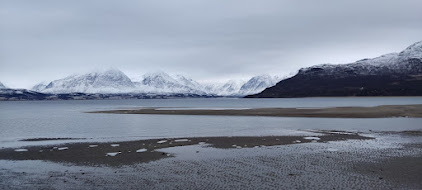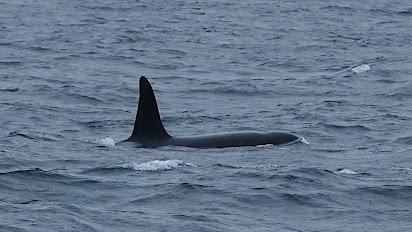Spent a fab weekend in the frozen north of Norway, 300 miles inside the Arctic circle, with my best mate, Philip.
The main reason for the trip was to look for Orcas, which follow the Herring into the fjords, which are seeking shelter in the winter. Since seeing Orcas on my honeymoon in British Columbia, back in 2003, I have become a little obsessed with these majestic devilfish and was desperate to see these Type 1 Eastern North Atlantic ecotypes in the icy waters of the Norwegian Sea. This was going to be my chance!

We spent our first day birding around the area, checking out the scenery and local wildlife, as far as the Finnish border. It was cold - really cold - with snow and ice covering the uplands and even down to sea level on the first day. Birding was challenging as most stuff had departed for the winter, and we failed to find any Siberian specialities in the few hours of daylight we had available. The woods were iced up and silent, apart from borealis Willow Tits, (Northern) Bullfinches and the occasional Jay or Magpie. An angry mob of Hooded Crows and Ravens directed us to an immature male Goshawk which eventually broke cover and flew straight over our heads -unfortunately our cameras were in the car, but it was a handsome, streaky beast and it powered off across the fjord towards the adjacent wooded hillside. Three barndoor-esque White-tailed Eagles were seen during the day, plus plenty of Velvet Scoters, Long-tailed Ducks, Red-breasted Mergansers and a solitary Great Northern Diver. We scoured Common Eider flocks for rarer cousins, without success.
One of the highlights of the day was encountering a couple of large herds of free-roaming - but domestic - Reindeer up on the high plateau near the Finnish border. Reindeer in most of Norway are domesticated like these, with the only wild animals in the far east and south, but they were still great to see doing their thing, licking salt off the road!
The other highlight was seeing how the birch and willow forest cloaked the mountainsides, creeping up the slopes and becoming patchy montane scrub in the higher areas. It gave the mountains a really different character to the bare, overgrazed fells back home and a glimpse of how projects like Wild Ingleborough could look in a few decades. It would be great to come back and see what this looks like in summer. One day, maybe!

Breidvik and adult White-tailed Eagle


Forest track somewhere near Nordbotn and Willow Tits (both pics by Philip Precey).
The Norway-Finland border. There was not much, apart from a rock cairn and this sign.
Montane woodland and scrub at c600-900m
Orcas
I could barely get to sleep the night before this trip! The chance to see Orcas anywhere is great, but to see them in the spectacular surroundings of Arctic Norway was just too exciting. We met our guides for the day down at Tromso harbour, as the first hint of light was starting to show in the leaden sky. I chose the boat trip with Brim Explorer because their vessel is a hybrid catamaran, meaning they switch to electric power when in the area where the whales are, to reduce disturbance. They also have a marine biologist on board who ensures the clients learn a lot about cetaceans and also makes sure we do not disturb the animals at all. I was very impressed with the way they operated the trip, not least because you could get a pint on board!
The impressive Brim Explorer and a map showing Tromso and Skjervoy. It is a long way north!
We headed northeast towards Skjervoy, but came across a pod of Orcas off Russelv, so didn't go quite so far. Due to the chilly, wet weather, most clients stayed inside for the whole time, so we had lots of space to share on the multiple decks, with the other dozen brave souls. I think some of those inside may have looked up from their smartphones and lattes to see the Orcas out of the window!
The Orca pod included a female identifiable by the parallel black scars on her grey saddle, as NKW-162 and hopefully the Norwegian Orca Survey will confirm some info about her and the rest of the pod.
NKW-162
Her saddle complete with scars:
The pod were hanging out in the fjord, feeding on Herring, and they approached very close to check us out a couple of times, giving breathtaking views. It was pretty emotional as always, seeing these incredible, beautiful animals so close, in such stunning surroundings. Fortunately, the rain and icy wind hid my tears! I had forgotten how conspicuous Orca blows are and also how it is quite noisy- being audible at quite a distance, even in breezy conditions.
The pod contained a large adult male with a collossal two metre tall dorsal fin, which came slowly out of the water like a triangular periscope. He was usually accompanied by a younger male with a smaller, though still impressive fin. There were three or so adult females too, including the one we identified, plus some immatures and a calf, maybe a couple of years old.
Top two, the adult male, bottom the younger male
One of the other adult females.
The pod. Gorgeous!
There were good numbers of Little Auks feeding in the area too which were scattered by the surfacing Orcas. You can just about see them in the videos.
The Orcas hung out for about 90 minutes before they drifted away. The light was starting to fail, so we headed back to Tromso.
Minke Whale hunting is still a thing in Norway, so it is good to come here to watch whales. We told as many people as we could why we had come, but it was heart-breaking to see whale meat products for sale in some of the tourist shops in the city. It was dreadful to think that people who go out on these whale-watching trips may then go and buy a whale meat sausage, without thinking about the consequences of their actions.
To watch a compilation of Orca videos I filmed on the trip, click here.
It seemed apt to celebrate our Orcas with a pint from Brim's bar as we sailed home!
...
Our last day was spent walking round the north end of Tromso island, looking for birds. We added a few species to our small list, including Northern Treecreeper, Goldcrest, Blue Tit and Black Guillemot (sadly not Mandt's!). Soon, darkness descended again and our trip came to an end.
Tromso, on a dreary afternoon.
Above- drake Common Eider. Most of the Eiders we saw close were not borealis, to our surprise. Below, a bunch of Long-tailed Ducks in Tromso harbour.




























































